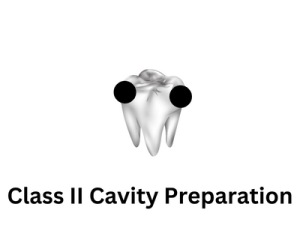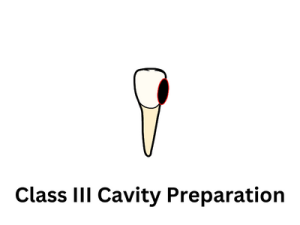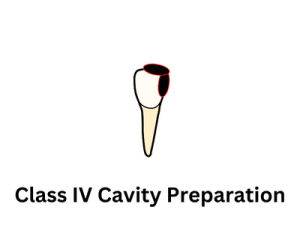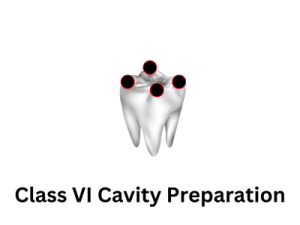Cavity preparation is a procedure to remove the decayed portion of the tooth and form a well-designed shape to seat the restorative material firmly. Making a cavity requires a great amount of expertise and knowledge to reduce a minimal amount of tooth structure while saving the important aspects of the tooth. Cavity preparation is classified into multiple classes based on the extent of the decay.
GV Black classified cavity preparation into six classes based on shapes.

Class 1 cavity preparation
Class 1 cavity preparation comprises all pits and fissures cavities. It further divides into three groups:
- Cavity preparation on the occlusal surface of molars and premolars
- Buccal and lingual pits of molars
- Cavity preparation on the lingual surfaces on maxillary incisors
Class 1 cavity is prepared on teeth where only the occlusal surface of posterior teeth is decayed or if the occlusal surface is decayed with lingual or buccal pits. This class is used when the caries are in their initial stages and is not affecting other surfaces.

Class 2 Cavity preparation
Class 2 cavity preparation is for the proximal surfaces of molars and premolars. This cavity is made in posterior teeth when the proximal surfaces are decayed.
Mesio-occlusal or disto-occlusal cavity preparation comes under this class of cavity preparation.

Class 3 Cavity preparation
Class 3 Cavity preparation is made on the proximal surfaces of anterior teeth, not including the incisal edges.
If an anterior tooth is decayed proximally, then the class 3 cavity is prepared.

Class 4 Cavity preparation
Class 4 cavity preparation is made on the proximal surfaces of anterior teeth along with incisal edges.
If the proximal surfaces of anterior teeth are decayed along with incisal surfaces, then the class 4 cavity is prepared.

Class 5 Cavity preparation
Class 5 cavity is prepared on gingival one-third of facial or lingual surfaces of anterior and posterior teeth.
If there is caries in the gingival part of any teeth, a Class 5 cavity is prepared.

Class 6 Cavity preparation
Class 6 cavity is prepared on the cusp tips of canines, premolars and molars.
If there is caries/decay on the cusp tips of posterior teeth, then the class 6 cavity is prepared to treat the tooth.
Frequently Asked Questions
Here are answers to some of the frequently asked questions by our users.
What classification would a mod on tooth #14 be?
A MOD on Tooth 14 will fall under Class 3 cavity preparation as it involves occlusal and proximal surfaces.
Which are the most common teeth with a class 3 cavity?
Class 3 cavity preparation is for anterior teeth. The most common tooth to having a class 3 cavity is the Maxillary incisor.
MO cavity falls under which classification?
It falls under Class 2 cavity preparation. MO on #14,#15,#16,#17,#18,#24,#25,#26,#27,#28,#34,#35,#36,#37,#38,#44,#45,#46,#47,#48, come under Class 2 Cavity.
DO cavity falls under which classification?
It is similar to MO and falls under the Class 2 Cavity preparation. DO on #14,#15,#16,#17,#18,#24,#25,#26,#27,#28,#34,#35,#36,#37,#38,#44,#45,#46,#47,#48, come under Class 2 Cavity.
MOD cavity falls under which classification?
In a MOD cavity, mesial and distal surfaces are prepared along with the occlusal surface, which falls under the class 2 cavity. MOD on #14,#15,#16,#17,#18,#24,#25,#26,#27,#28,#34,#35,#36,#37,#38,#44,#45,#46,#47,#48, come under Class 2 Cavity.
What does MO cavity mean?
MO stands for Mesio occlusal cavity. Occlusal and mesial surfaces are prepared in this type of cavity.
What does DO cavity mean?
DO stands for Disto occlusal cavity. Occlusal and distal surfaces are prepared in this type of cavity.
What does MOD cavity mean?
MOD stands for Mesiodistal occlusal cavity. Occlusal, distal and mesial surfaces are prepared in this type of cavity.